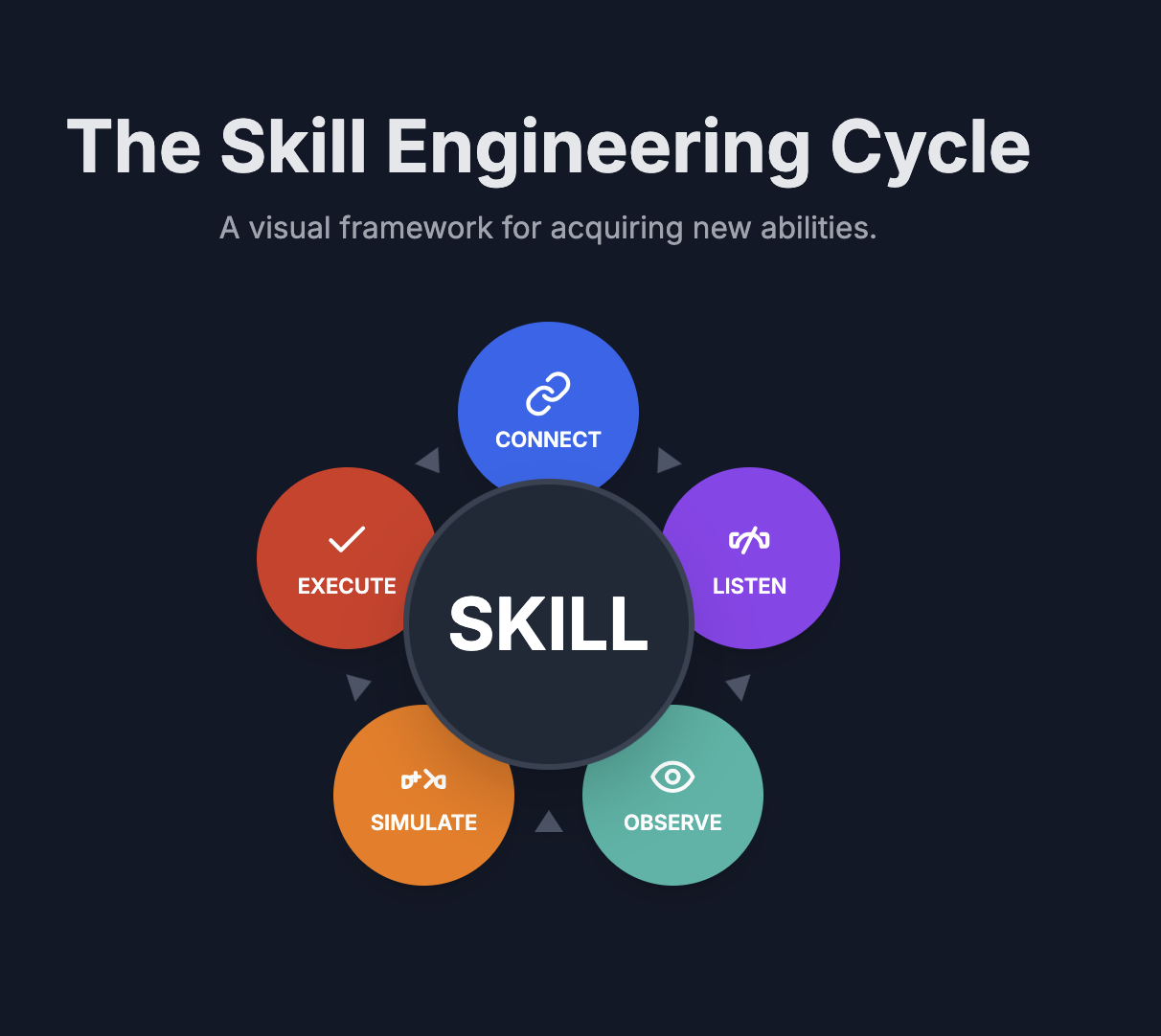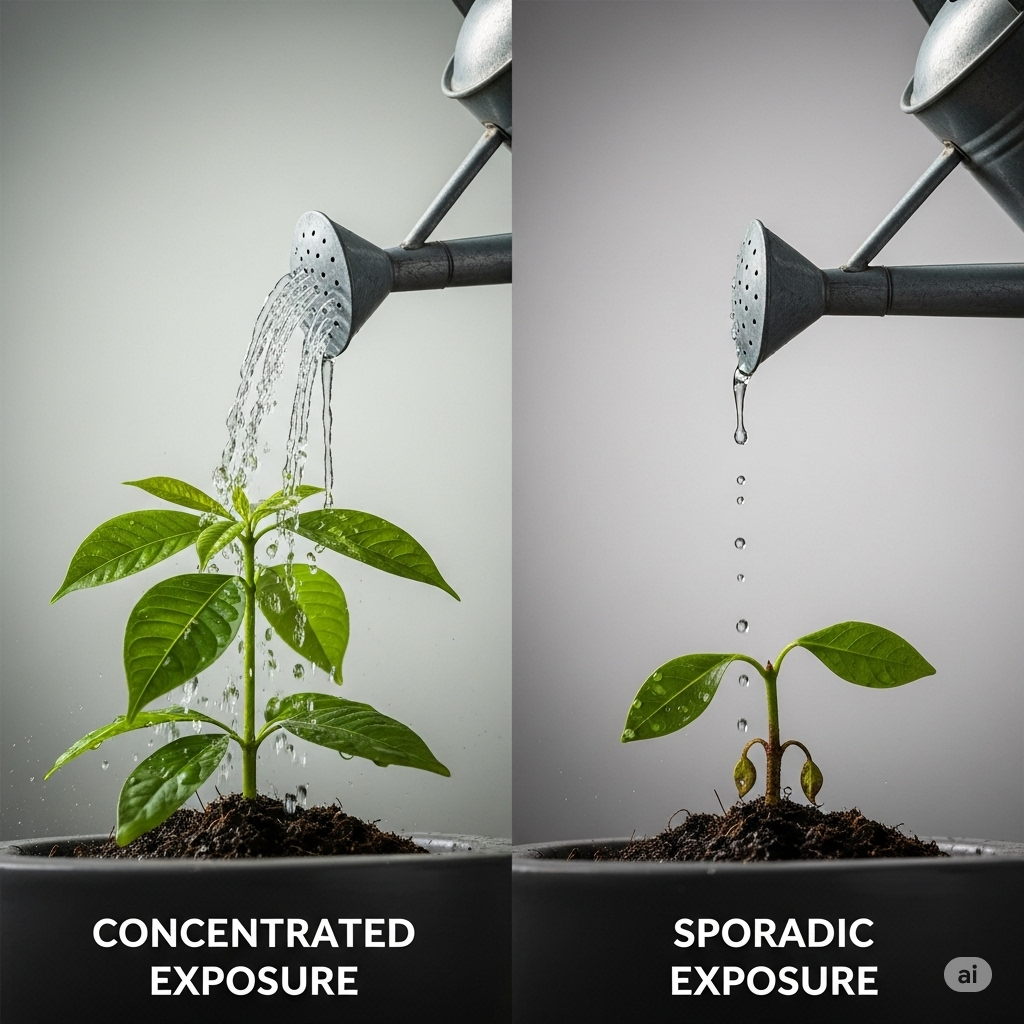The Exposure Effect: How Environment Shapes 'Natural' Talent (Part 2)
Stop waiting for experience. Learn any business skill fast with the CLOSE framework—a system to engineer intentional exposure and accelerate your growth.

Summary
Transform your understanding into action with a systematic framework for creating intentional exposure that accelerates skill development. Learn how to design your own learning environment, identify high-value exposure opportunities, and compress years of accidental learning into months of focused skill building. This isn't just about observing—it's about engineering the conditions that create apparent "natural talent" in yourself.
Key Points
- The CLOSE Framework (Connect, Listen, Observe, Simulate, Execute) systematically creates exposure experiences
- "Exposure density" matters more than exposure duration—concentrated learning beats sporadic practice
- You can create indirect exposure through strategic content consumption and case study analysis
- Modern technology allows unprecedented access to expert thinking patterns and processes
- The "simulation phase" bridges the gap between observation and real-world application
Key Takeaways
- Engineer exposure opportunities rather than waiting for them to occur naturally
- Focus on understanding thought processes, not just observing outcomes
- Use multiple exposure channels simultaneously for accelerated learning
- Document patterns you observe to build your own mental frameworks
- Start applying skills in low-risk environments before high-stakes situations
Now that you understand how exposure creates what we mistake for "natural talent," the question becomes: How do you systematically create the kind of concentrated exposure that normally takes years to accumulate accidentally?
This is where most people get stuck. They understand the principle but don't know how to engineer the learning environment. Today, I'll give you the exact framework I've used to rapidly develop skills from financial modeling to AI tool development, along with strategies that work even when you don't have direct access to experts.
The CLOSE Framework: Engineering Intentional Exposure
After analyzing my own successful skill acquisitions and studying how others compress learning timelines, I've identified a five-phase system that creates concentrated exposure systematically. I call it the CLOSE Framework:

C - Connect (Find Your Exposure Sources)
The first step is identifying where and how you can gain access to skilled practitioners applying the competency you want to develop.
Direct Access Sources (Highest Value):
- Mentors or colleagues who regularly use the skill
- Industry associations or networking groups where practitioners gather
- Volunteer opportunities that put you alongside experts
- Freelance or part-time work in environments where the skill is applied daily
Indirect Access Sources (Still Highly Valuable):
- Detailed case studies that reveal thought processes, not just outcomes
- Podcasts or videos where experts explain their reasoning step-by-step
- Technical documentation or process guides created by practitioners
- Online communities where professionals discuss real challenges and solutions
Real Example from My AI Learning Journey: When I decided to learn AI tool development, I couldn't work directly with expert developers. Instead, I connected through:
- YouTube channels where developers built projects from scratch, explaining their thinking
- GitHub repositories with detailed documentation showing code evolution
- Reddit community forums where people shared both successes and failures
- Product Hunt launches where I could see how successful tools were structured and marketed
L - Listen (Capture Thought Processes, Not Just Techniques)
Most people focus on what experts do. The real value is understanding how they think—the mental models and decision-making processes that guide their actions.
What to Listen For:
- How they break down complex problems into manageable components
- What questions they ask when approaching new challenges
- How they prioritize when multiple solutions are possible
- What they consider when evaluating options or risks
- How they recover when their initial approach doesn't work
The L&T Cost Proposal Learning: Remember my colleague who seemed naturally gifted at financial modeling? The breakthrough came when I started listening to his thought process during discussing with my manager, not just watching his spreadsheet work. I heard him say things like:
- "Let's us close the big ticket items because small errors there matter most"
- "When clients ask for pricing, they're usually also evaluating our understanding of their priorities"
- "I build in buffers for scope changes and wastages, calculated based on our historical project data, not guesswork"
These weren't techniques—they were mental frameworks that guided every decision he made.
Modern Advantage: Today, you have unprecedented access to expert thinking through podcasts, detailed blog posts, video tutorials, and online courses where practitioners explain their reasoning in real-time.
O - Observe (Study Patterns Across Multiple Examples)
Single examples teach techniques. Multiple examples reveal patterns—the underlying principles that apply across different situations.
What to Observe:
- Common approaches used by different experts facing similar challenges
- Variations in technique based on context or constraints
- Mistakes and corrections that reveal expert judgment in action
- Tools and resources that skilled practitioners consistently rely on
- Communication patterns they use when explaining or selling their work
Personal Example - Marketing Learning at Ola: When I needed to develop marketing competency quickly, I didn't just study one successful campaign. I analyzed dozens plans previously executed at Ola and Uber, looking for patterns:
- Successful campaigns typically focused on how much bookings growth was observed when ran our campaign and how much loss we took when Uber ran one. It helped me understand what type of campaign work best
- Geographic variability as some types worked better in a city but same failed in another city
- Customer acquisition costs varied by channel, focussed heavily on which channel gave us customer who were still booking with us 90 days later
The Pattern Recognition Advantage: Our brain is exceptionally good at detecting patterns when given sufficient examples. By observing multiple expert applications of the same skill, you can easily develop the ability to adapt principles to new situations rather than just copying specific techniques.
S - Simulate (Practice in Low-Risk Environments)
This is the bridge between observation and real-world application. Simulation lets you test your understanding and build neural pathways without the pressure of high-stakes outcomes.
Simulation Strategies:
- Case study analysis: Apply your developing mental models to historical situations where you know the outcomes
- Hypothetical scenarios: Work through "what would you do if" situations based on real challenges you've observed
- Mock projects: Create practice versions of real work using different contexts or constraints
- Teaching others: Explain what you've learned to colleagues or friends—teaching reveals gaps in understanding (something I am doing by building this blog)
- Tool replication: Rebuild spreadsheets, processes, or frameworks you've studied to understand their logic

AI Tools Simulation Example: Before developing a new website for my company, I spent weeks replicating simple website projects I found online. I would:
- Follow tutorials exactly to understand basic mechanics
- Modify them slightly to test my comprehension
- Combine elements from different tutorials to create new variations
- Apply them to hypothetical design problems different from the original examples
This simulation phase was crucial. When I eventually built my website for my business , I had already worked through most of the common problems and decision points in a low-pressure environment.
- For those keen to understand how my skills evolved, here is link to the first website I built using AI and my current website I have developed
- Even my current blog has been rebuilt from an older theme
E - Execute (Apply Skills to Real Challenges)
The final phase moves from simulation to actual application, but with strategic safeguards that minimize risk while maximizing learning.
Execution Strategies:
- Start small: Apply the skill to low-stakes but real situations first
- Seek feedback early: Get input from experts or experienced practitioners before completing projects
- Document everything: Record what works, what doesn't, and what you'd do differently
- Iterate rapidly: Use early real-world applications to refine your approach quickly
- Build progressively: Take on increasingly complex applications as competency develops
The Cost Proposal Execution: When my L&T colleague went on leave and I was asked to develop pricing for new work, I can clearly see the same framework in action:
- I started with a smaller, less critical proposal to test my approach
- I built in extra time for multiple iterations and feedback cycles
- I documented every decision and the reasoning behind it
- I compared my final work to historical successful proposals to identify gaps
- I used lessons from that first project to improve subsequent proposals
The Exposure Density Principle: Why Concentration Beats Duration
Here's a crucial insight that most people miss: exposure density matters more than exposure duration. Six months of daily exposure beats five years of monthly exposure every time.
The Neuroscience Behind It: Your brain strengthens neural pathways through repetition frequency, not just total repetition count. Daily exposure creates stronger, more accessible mental patterns than the same total exposure spread over longer periods.
Practical Application:
- Better: Study expert sales calls for 30 minutes daily for one month
- Worse: Attend one sales training workshop per quarter for two years
- Better: Analyze three marketing campaigns per week for six weeks
- Worse: Review one campaign per month for 18 months

The Business Implication: When you're serious about developing a skill, engineer periods of concentrated exposure rather than hoping gradual exposure will eventually accumulate into competency.
Creating Indirect Exposure: When You Can't Access Experts Directly
Most aspiring entrepreneurs don't have direct access to world-class practitioners in every skill they need. Here's how to create high-value exposure through indirect methods:
Strategy 1: Reverse-Engineer Excellence
Find the best examples of the skill being applied in your industry, then work backwards to understand the thinking that produced those results.
I am currently keen to improve my skills in Content Marketing. So this is how I plan to go about it as its not possible for me to work with expert marketers:
- Identify 10 companies with exceptional content in my industry
- Analyze their best-performing pieces for structure, messaging, and distribution strategy
- Track their content evolution over 6-12 months to see how they adapt and improve
- Study their promotion tactics across different channels and platforms
- Map their content to their business goals and customer journey stages
What You're Building: Mental models for how great content marketers think about audience needs, message positioning, and strategic distribution.
I have started working on improving my business local seo presence around 2 weeks as of this post.
Strategy 2: Expert Process Documentation
Many skilled practitioners have documented their thinking processes in books, courses, or detailed articles. This creates concentrated exposure to their mental models.
High-Value Sources:
- Technical books written by practitioners, not just academics
- Detailed case studies that include decision-making rationale
- Process documentation from successful companies or consultants
- Interview transcripts where experts explain their approaches step-by-step
- "How I built this" content that reveals thinking behind successful outcomes
Personal Example: When developing AI tool capabilities, I found incredible value in reading technical documentation written by software engineers than seeing video tutorials. Unlike tutorials that just show steps, this documentation revealed:
- Why certain approaches were chosen over alternatives
- How problems were debugged when initial solutions failed
- What trade-offs were considered in different design decisions
- How solutions evolved as requirements became clearer
Thought I won't become a Software Engineer, I am more clear on how to think as one, allowing me guide AI tools with more confidence
Strategy 3: Community Immersion
Join online reddit communities where practitioners discuss real challenges and solutions. This provides ongoing exposure to expert thinking patterns.
High-Value Communities:
- Industry-specific forums where professionals solve actual problems
- Professional social media groups with active expert participation
- Question-and-answer platforms where experts explain their reasoning
- Live streaming or video calls where you can observe expert problem-solving in real-time
What Makes This Effective: You're not just reading about best practices—you're observing how experts think through novel problems and adapt their knowledge to new situations.
I always browse through reddit communities whenever bored, reading user comments across a wide array of topic as it provides me insight that is hard to come by on a regular basis.
The Technology Multiplier: Leveraging Modern Exposure Tools
Today's technology creates exposure opportunities that were impossible just a few years ago:
AI-Powered Learning Acceleration
Modern AI tools can simulate expert consultation and feedback, creating exposure experiences that bridge the gap between observation and mentorship.
Example Applications:
- Use AI to role-play challenging business conversations before real meetings
- Get AI feedback on your strategic thinking before implementing decisions
- Simulate different scenarios to test your developing mental models
- Generate practice problems based on real-world challenges in your industry
My Current Approach: I now use AI as a thinking partner when developing business strategies. I can test my reasoning, explore alternative approaches, and identify potential blind spots before making important decisions. This creates exposure to strategic thinking patterns that would normally require years of mentorship to develop.
Digital Documentation and Pattern Recognition
Modern tools let you document and analyze your learning in ways that accelerate pattern recognition:
Documentation Strategies:
- Video record yourself applying new skills to identify improvement areas
- Screenshot or save examples of excellent work for pattern analysis
- Use note-taking apps to capture and cross-reference insights from multiple sources (NotebookLLM is an excellent resource)
- Build personal databases of techniques, frameworks, and lessons learned
The 90-Day Intensive Exposure Plan
Here's how to apply the CLOSE framework systematically to develop any business skill in three months:
Month 1: Connect and Listen (Foundation Building)
Week 1-2: Identify and Access Sources
- Map your target skill to find the best practitioners and examples
- Join relevant communities and start following expert content creators
- Collect 20-30 high-quality examples of the skill being applied excellently
Week 3-4: Deep Listening and Pattern Recognition
- Study expert thought processes through interviews, documentation, or detailed case studies
- Create your first mental model framework based on patterns you observe
- Begin documenting insights and questions for deeper investigation
Month 2: Observe and Simulate (Skill Building)
Week 5-6: Multi-Source Observation
- Analyze variations in how different experts approach similar challenges
- Identify core principles that remain consistent across different contexts
- Study failure cases to understand common pitfalls and recovery strategies
Week 7-8: Intensive Simulation
- Practice on historical cases where you can verify your thinking against known outcomes
- Build mock projects that test your developing mental models
- Seek feedback from any accessible experts or knowledgeable peers
Month 3: Execute and Refine (Real-World Application)
Week 9-10: Low-Stakes Real Application
- Apply your skill to actual but low-risk business challenges
- Document everything you learn about the gap between theory and practice
- Iterate quickly based on real-world feedback
Week 11-12: Progressive Challenge Increase
- Take on more complex applications as confidence builds
- Compare your work to expert examples to calibrate your progress
- Build your personal framework for continued improvement in this skill
The Compound Learning Effect: How Each Skill Accelerates the Next
Here's something remarkable I've discovered: each skill you develop through intentional exposure makes subsequent skills easier to acquire. You're not just learning individual competencies—you're building meta-learning capabilities.
The Pattern Transfer Effect: Mental models from one domain often apply to others. The systematic thinking I developed through financial modeling helped me approach marketing strategy more effectively. The pattern recognition skills from AI development improved my ability to analyze business processes.
The Confidence Multiplier: Successfully applying the CLOSE framework to one skill builds confidence in your ability to learn others. This reduces the psychological barriers that often prevent people from attempting new competencies.
Strategic Implication: Choose your first intentional exposure project carefully. Success creates a learning momentum that compounds across multiple skill development efforts.
Measuring Your Exposure ROI: How to Know It's Working
Unlike traditional education, exposure-based learning can be difficult to measure. Here are reliable indicators that your intentional exposure is creating real competency:
Early Indicators (Weeks 2-4):
- You start recognizing patterns in expert work that were invisible before
- You can predict what experts will do in familiar situations
- You ask better questions when seeking help or clarification
- You spot mistakes in examples or applications that seemed perfect initially
Development Indicators (Weeks 6-8):
- You can explain the reasoning behind expert decisions to others
- You successfully adapt techniques you've observed to new situations
- Others start asking for your input on related challenges
- You feel confident taking on real applications with appropriate support
Competency Indicators (Weeks 10-12):
- You produce work that experts evaluate positively
- You can troubleshoot problems that arise during real applications
- You recognize when situations are beyond your current skill level
- You continue improving without constant external guidance
Your Personal Exposure Action Plan
Based on everything we've covered, here's how to start implementing intentional exposure for any skill your business needs:
Step 1: Skill Selection and Exposure Mapping (Week 1)
- Choose one specific skill that would significantly impact your business success
- Identify 3-5 accessible sources of expert application (direct or indirect)
- Map your learning timeline using the 90-day intensive framework
- Set up systems for documenting insights and tracking progress
Step 2: Foundation Building (Weeks 2-5)
- Immerse yourself in expert content and communities
- Create your first mental model based on observed patterns
- Start building your personal reference library of examples and insights
- Begin simulation exercises using historical cases or mock scenarios
Step 3: Real-World Application (Weeks 6-12)
- Apply your developing skill to actual but low-risk business challenges
- Seek feedback from experts or experienced practitioners
- Iterate rapidly based on real-world outcomes
- Document your learning for future reference and continuous improvement
Step 4: Competency Integration (Month 4+)
- Take on increasingly complex applications as skills develop
- Begin teaching what you've learned to others
- Start your next exposure project for the next priority skill
- Build systems for maintaining and improving existing competencies
The Mindset Shift That Accelerates Everything
Throughout this process, remember the fundamental mindset shift from Part 1: the people who seem naturally gifted at business skills have simply accumulated more relevant exposure than you have—so far.
Old Approach: "I need to find someone naturally gifted at [skill] to handle this for my business."
New Approach: "I need to engineer concentrated exposure to [skill] so I can develop competency quickly and make better strategic decisions."
This shift changes everything about how you approach business challenges. Instead of accepting dependence on others for critical capabilities, you become intentional about building the specific competencies your business needs most.
The Strategic Advantage: Entrepreneurs who master intentional exposure don't just build individual skills—they build the ability to rapidly acquire new competencies as their business evolves. In a fast-changing economy, this meta-learning capability becomes one of your most valuable competitive advantages.
The exposure effect isn't just about individual skill development. It's about transforming yourself into the kind of entrepreneur who can adapt, learn, and excel regardless of what challenges emerge in your business journey.
The question isn't whether you have natural talent for the skills your business needs. The question is: How quickly can you engineer the exposure that will build those capabilities?
Start with one skill. Apply the CLOSE framework systematically. Give yourself permission to be a beginner while you accumulate the exposure that will make you competent.
Three months from now, people will start saying you're "naturally good" at something you're learning today. You'll know the truth: it wasn't natural talent—it was intentional exposure, systematically applied.
Which skill will you choose first?
FAQ
Q: What if I can't commit 90 days to intensive exposure for one skill?
The framework scales down. Even 30 days of concentrated exposure (45-60 minutes daily) can build significant competency. The key is consistency and focus on one skill rather than scattered efforts across multiple areas. Part-time intensive beats full-time sporadic every time.
Q: How do I balance learning new skills with running my current business?
Choose skills that directly impact your immediate business needs, so the learning pays dividends immediately. Also, many exposure activities (listening to expert podcasts, analyzing case studies) can happen during commute time or other "dead" periods in your schedule.
Q: What if the experts I want to learn from aren't accessible through any of these methods?
Look for their intellectual descendants—people they've trained, mentored, or influenced. Study companies or projects where these experts have been involved. Often, their approaches and thinking patterns are embedded in the organizations they've built or influenced.
Q: How do I know if I'm learning the right things vs. just mimicking surface-level behaviors?
Focus on understanding the "why" behind expert actions, not just the "what." If you can explain the reasoning behind decisions and successfully adapt techniques to new situations, you're building real competency. If you can only copy exact behaviors, you need deeper exposure to thought processes.
Q: Should I focus on learning from one expert or study multiple practitioners?
Multiple practitioners. Studying various experts helps you identify universal principles vs. personal styles. However, if you find one expert whose thinking particularly resonates with your situation, it's worth doing deeper study of their approach before moving to others.
Q: How do I maintain skills I've developed while learning new ones?
Use them regularly in your business context, and schedule monthly reviews to prevent skill decay. The advantage of business skills is they're meant to be applied continuously. Also, many business skills reinforce each other—financial modeling supports strategic thinking, communication skills enhance sales abilities, etc.